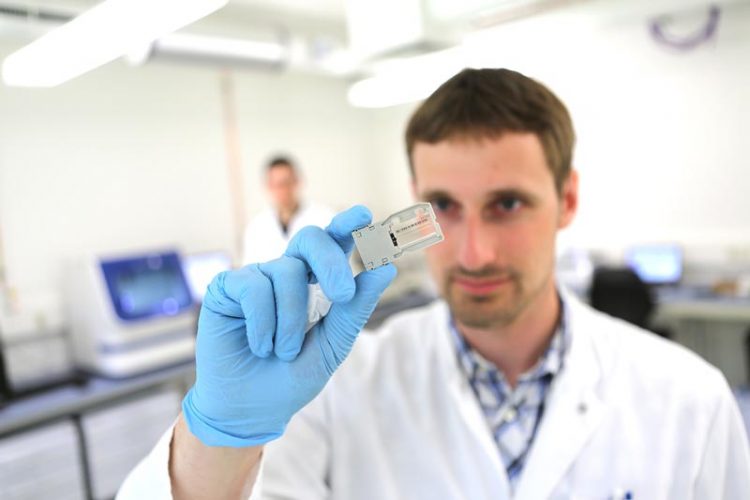Breakthrough in tuberculosis research: genetic pathogen code is the key for optimum treatment

The entire genome at a glance: Thomas Kohl from the Research Center Borstel preparing samples for Whole Genome Sequencing. Photo/Copyright: German Center for Infection Research/scienceRELATIONS
Detection of TB pathogens and the precise determination of antibiotic resistance was, until now, only done with culture procedures. This method requires up to six weeks until a result is available. Valuable time, which frequently delays effective treatment.
The procedures using cultures are also relatively prone to error. They need to be very precise, however, in order to obtain reliable and comparable results, and such ideal lab conditions are also usually not available in countries with high tuberculosis rates, in particular. Even the molecular-diagnostic quick tests used over the last 20 years can only provide information on a limited number of mutations and the resistances which result from them.
“We wanted to go one step further and give therapeutic pointers on which combinations of antibiotics are suitable for treating a certain pathogen”, summarized Professor Stefan Niemann, Head of the Molecular Mycobacteriology research group at the Research Center Borstel and member of the Cluster of Excellence Inflammation at Interfaces, to describe the research approach. “We are moving from 130 years of TB cultivation towards a new, digital era in microbiology.”
To do so, the team investigated the genomes from around 3500 strains of TB, using the Whole Genome Sequencing method (WGS). The researchers concentrated on changes to the genome which they could connect to antibiotic resistance and sensitivity.
“We have established a kind of dictionary for mutations in the genomes of TB pathogens”, explained Niemann. “If changes to the genetic code are found in a patient isolate, then certain medications are no longer effective and should therefore not be used for treatment. This is an enormous advance in progress, particularly in terms of treating multi-resistant pathogens!”
It will take some time until the method can be applied by physicians in everyday practise. However Dr Thomas Kohl, co-author of the publication, believes that the method has great potential: “In the long term, genome analysis is significantly easier and cheaper to carry out than developing cultures. Above all, with regard to the WHO EndTB strategy, which plans to successfully end tuberculosis by 2035, these new diagnostic approaches are very important.”
Tuberculosis (TB) is the most frequent deadly contagious disease worldwide. Estimates think that around one third of the world's population is infected with the pathogen. For the majority of those infected, however, tuberculosis never breaks out. Each year 9 million people contract TB – and around 1.5 million die as a result of its consequences. The ever increasing antibiotic resistances of the pathogens are an immense problem. This considerably extends the duration of treatment and causes high costs.
Original publication:
Walker, TM, Kohl, TA, Omar, SV, Hedge, J, Elias, CDO, Bradley, P, Iqbal, Z, Feuerriegel, S, Niehaus, KE, Wilson, DJ, Clifton, DA, Kapatai, G, Ip, C, Bowden, R, Drobniewski, FA, Allix-Béguec, C, Gaudin, C, Parkhill, J, Diel, R, Supply, P, Crook, DW, Smith, EG, Walker, AS, Ismail, N, Niemann, S, Peto, TEA and Modernizing Medical Microbiology (MMM) Informatics Group (2015): Whole-genome sequencing for prediction of Mycobacterium
tuberculosis drug susceptibility and resistance: a retrospective cohort study. The Lancet Infectious Diseases, http://dx.doi.org/10.1016/S1473-3099(15)00062-6 (as from June 24, 01:00 CET)
Contact:
Professor Dr Stefan Niemann
Research Center Borstel / Cluster of Excellence Inflammation at Interface s
German Center for Infection Research
Tel.: +49 (0)4537/ 188-7620
E-mail: sniemann@fz-borstel.de
Press contact:
Dr Tebke Böschen
Tel: +49 (0)431 880-4682, e-mail: tboeschen@uv.uni-kiel.de
Website: http://www.inflammation-at-interfaces.de
Britta Weller
Tel: +49 (0)4537 188-2890, e-mail: bweller@fz-borstel.de
Website: http://www.fz-borstel.de
http://inflammation-at-interfaces.de/en/newsroom/current-issues/breakthrough-tub…
Media Contact
All latest news from the category: Life Sciences and Chemistry
Articles and reports from the Life Sciences and chemistry area deal with applied and basic research into modern biology, chemistry and human medicine.
Valuable information can be found on a range of life sciences fields including bacteriology, biochemistry, bionics, bioinformatics, biophysics, biotechnology, genetics, geobotany, human biology, marine biology, microbiology, molecular biology, cellular biology, zoology, bioinorganic chemistry, microchemistry and environmental chemistry.
Newest articles

NASA: Mystery of life’s handedness deepens
The mystery of why life uses molecules with specific orientations has deepened with a NASA-funded discovery that RNA — a key molecule thought to have potentially held the instructions for…

What are the effects of historic lithium mining on water quality?
Study reveals low levels of common contaminants but high levels of other elements in waters associated with an abandoned lithium mine. Lithium ore and mining waste from a historic lithium…

Quantum-inspired design boosts efficiency of heat-to-electricity conversion
Rice engineers take unconventional route to improving thermophotovoltaic systems. Researchers at Rice University have found a new way to improve a key element of thermophotovoltaic (TPV) systems, which convert heat…



